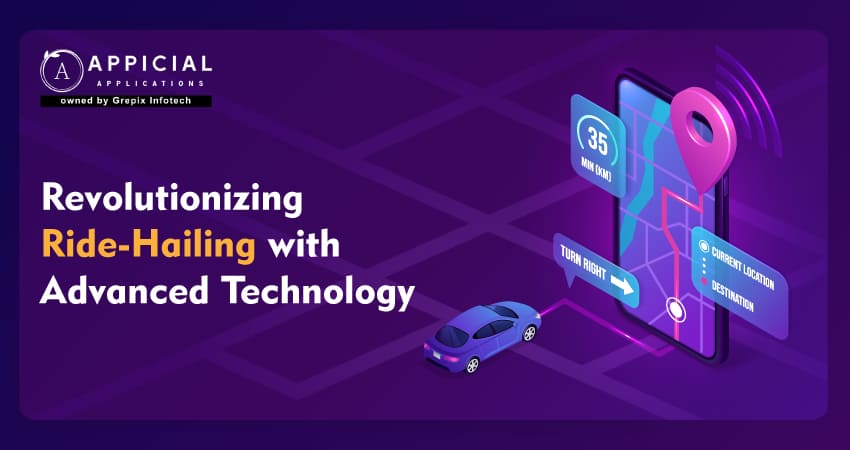
Revolutionizing Ride-Hailing with Advanced Technology
The ride-hailing industry has witnessed a remarkable transformation over the past decade, driven by rapid advancements in technology. What began as a simple concept of hailing a ride has evolved into a sophisticated, tech-driven ecosystem that is redefining urban transportation. Companies like Uber, Lyft, and others have harnessed cutting-edge technologies to enhance convenience, efficiency, and safety for millions of users worldwide. From GPS navigation and AI-powered algorithms to the advent of autonomous vehicles, these innovations are not just improving our daily commutes but are also paving the way for a smarter, more sustainable future. In this blog, we delve into the advanced technologies that are revolutionizing ride-hailing, exploring their impact, benefits, and the exciting potential they hold for the future of mobility. Join us as we embark on a journey through the technological advancements reshaping the way we move in our cities.
The ride-hailing industry has been transformed by cutting-edge technologies such as GPS, AI, mobile apps, and autonomous vehicles. Companies like Uber and Lyft have leveraged these innovations to enhance accessibility, efficiency, and safety. GPS and navigation systems enable accurate ride matching and real-time tracking, while AI optimizes pricing, demand prediction, and security. Autonomous vehicles promise to reduce costs and improve safety, although regulatory and technical challenges remain. The future of ride-hailing will see further integration of multi-modal transportation, personalization, and sustainable practices, making urban mobility more intelligent and connected. This blog explores these advancements and their impact on ride-hailing services.
The Evolution of Ride-Hailing
Before we dive into the technological advancements, it's important to understand how ride-hailing has evolved. The traditional taxi system, with its fixed routes and schedules, was often inconvenient for many passengers. The introduction of ride-hailing apps like Uber and Lyft in the early 2010s brought a paradigm shift, offering convenience, affordability, and a personalized experience.
These platforms allowed users to book rides from their smartphones, track their driver's location in real-time, and pay electronically. This was just the beginning, as technology continued to evolve, making ride-hailing even more efficient and user-friendly.
Artificial Intelligence and Machine Learning
Predictive Analytics and Demand Forecasting
One of the most significant contributions of artificial intelligence (AI) and machine learning (ML) to ride-hailing is predictive analytics. By analyzing historical data, AI algorithms can predict demand patterns, helping companies allocate resources more efficiently. For instance, during peak hours or special events, ride-hailing companies can anticipate increased demand and deploy more drivers to specific areas, reducing wait times for passengers.
Dynamic Pricing
Dynamic pricing, also known as surge pricing, is another application of AI in ride-hailing. AI algorithms analyze various factors such as demand, traffic conditions, and driver availability to adjust fares in real-time. While this practice has been controversial, it ensures that supply meets demand, incentivizing drivers to be available during high-demand periods.
Route Optimization
AI and ML also play a crucial role in route optimization. By analyzing traffic data and using real-time navigation systems, AI can determine the most efficient routes for drivers. This not only reduces travel time but also saves fuel, benefiting both drivers and passengers. Companies like Uber use AI to continually update their maps and provide the best possible routes.
Autonomous Vehicles
The Future of Ride-Hailing
One of the most exciting technological advancements in the ride-hailing industry is the development of autonomous vehicles. Companies like Waymo, Tesla, and Uber are investing heavily in self-driving technology, aiming to create a future where rides are provided by autonomous cars.
Safety and Efficiency
Autonomous vehicles promise to enhance safety and efficiency. Equipped with advanced sensors and AI, these cars can navigate roads with precision, avoiding accidents caused by human error. Additionally, autonomous vehicles can operate around the clock, increasing the availability of ride-hailing services and reducing costs associated with human drivers.
Challenges and Considerations
Despite the potential benefits, there are significant challenges to overcome before autonomous vehicles become mainstream in ride-hailing. These include regulatory hurdles, technological limitations, and public acceptance. Ensuring the safety and reliability of self-driving cars remains a top priority for companies and regulators alike.
Also Read: How to Create a Ride-Sharing App in 2024: a Comprehensive Guide
Blockchain Technology
Enhancing Transparency and Security
Blockchain technology, known for its secure and transparent nature, is making its way into the ride-hailing industry. By using blockchain, ride-hailing companies can create tamper-proof records of transactions, enhancing trust between drivers and passengers. Blockchain can also help in verifying driver identities and maintaining accurate records of ride histories.
Decentralized Platforms
Blockchain enables the creation of decentralized ride-hailing platforms. Unlike traditional platforms controlled by a central entity, decentralized platforms operate on a peer-to-peer basis. This can reduce costs, as there are no intermediary fees, and increase competition, benefiting both drivers and passengers. Companies like Arcade City are exploring decentralized ride-hailing models.
Internet of Things (IoT)
Connected Vehicles
The Internet of Things (IoT) is transforming ride-hailing by connecting vehicles to the internet, enabling real-time data exchange. IoT devices can monitor various aspects of a vehicle's performance, such as fuel efficiency, engine health, and tire pressure. This data can help ride-hailing companies maintain their fleets more effectively, reducing downtime and improving service quality.
Enhanced Passenger Experience
IoT also enhances the passenger experience. For instance, connected vehicles can offer personalized entertainment options, adjust climate settings based on passenger preferences, and provide real-time updates on traffic conditions. These features contribute to a more comfortable and enjoyable ride.
Big Data and Analytics
Data-Driven Decision Making
The ride-hailing industry generates vast amounts of data daily. This data, when analyzed, can provide valuable insights into customer behavior, driver performance, and operational efficiency. Ride-hailing companies use big data analytics to make informed decisions, optimize their services, and identify areas for improvement.
Personalized Services
Big data analytics also enable personalized services. By analyzing user preferences and travel patterns, ride-hailing apps can offer tailored recommendations, such as preferred routes, vehicle types, and payment options. Personalization enhances customer satisfaction and loyalty.
Advanced Driver Assistance Systems (ADAS)
Advanced Driver Assistance Systems (ADAS) are becoming increasingly common in ride-hailing vehicles. These systems use sensors, cameras, and AI to assist drivers in various tasks, such as lane-keeping, collision avoidance, and parking. ADAS enhances safety by reducing the likelihood of accidents and improving overall driving performance.
Driver and Passenger Safety
Ride-hailing companies are also investing in technology to enhance driver and passenger safety. Features such as real-time driver monitoring, emergency response systems, and in-app safety tools provide an added layer of security. For instance, Uber's Real-Time ID Check uses facial recognition to verify drivers' identities, ensuring that the correct person is behind the wheel.
The Role of Mobile Technology
Seamless Booking and Payment
Mobile technology remains at the core of the ride-hailing experience. Modern ride-hailing apps offer seamless booking and payment options, making it easy for users to request rides and pay through their smartphones. Features like ride-sharing, split fares, and digital wallets have further simplified the process.
Real-Time Tracking and Communication
Real-time tracking and communication are essential components of ride-hailing apps. Passengers can track their drivers' locations in real-time, receive estimated arrival times, and communicate directly with drivers through the app. This transparency enhances the user experience and builds trust.
Sustainability and Green Initiatives
Electric and Hybrid Vehicles
As concerns about climate change and environmental sustainability grow, the ride-hailing industry is taking steps to reduce its carbon footprint. Many companies are incorporating electric and hybrid vehicles into their fleets, offering greener alternatives to traditional gasoline-powered cars. This transition not only benefits the environment but also reduces operational costs.
Carbon Offsetting Programs
Some ride-hailing companies have introduced carbon offsetting programs, allowing passengers to offset the emissions generated by their rides. By investing in renewable energy projects and reforestation efforts, these programs help mitigate the environmental impact of ride-hailing services.
The Future of Ride-Hailing
Continued Technological Advancements
The ride-hailing industry will continue to evolve as technology advances. Innovations in AI, autonomous vehicles, blockchain, and IoT will drive further improvements in efficiency, safety, and user experience. Companies that embrace these technologies and adapt to changing consumer preferences will remain at the forefront of the industry.
Expansion into New Markets
Ride-hailing companies are also expanding into new markets and diversifying their services. For example, some companies are exploring opportunities in food delivery, logistics, and public transportation. By leveraging their existing infrastructure and technology, ride-hailing companies can tap into new revenue streams and offer a broader range of services.
Regulatory and Ethical Considerations
As the ride-hailing industry grows, it will face increased scrutiny from regulators and the public. Ensuring compliance with local regulations, addressing ethical concerns, and prioritizing safety will be crucial for maintaining trust and legitimacy. Companies must work closely with policymakers to create a regulatory framework that balances innovation with public safety.
Conclusion
Advanced technology has revolutionized the ride-hailing industry, making transportation more efficient, safe, and accessible. Innovations such as GPS, AI, mobile apps, and autonomous vehicles have transformed how we navigate our cities and connect with transportation services. These technologies have not only enhanced the convenience and reliability of ride-hailing but also opened new possibilities for future developments.
As the industry continues to evolve, the integration of multi-modal transportation, personalized services, and sustainable practices will further reshape urban mobility. By embracing and harnessing these advancements, ride-hailing companies can drive forward a future where transportation is smarter, greener, and more inclusive. The journey of technological innovation in ride-hailing is just beginning, promising a future where the way we move is continually redefined and improved.
Looking out to start your own venture like Uber? Try out our HireMe Taxi Uber Clone, the easiest way to kick-start your taxi business.





